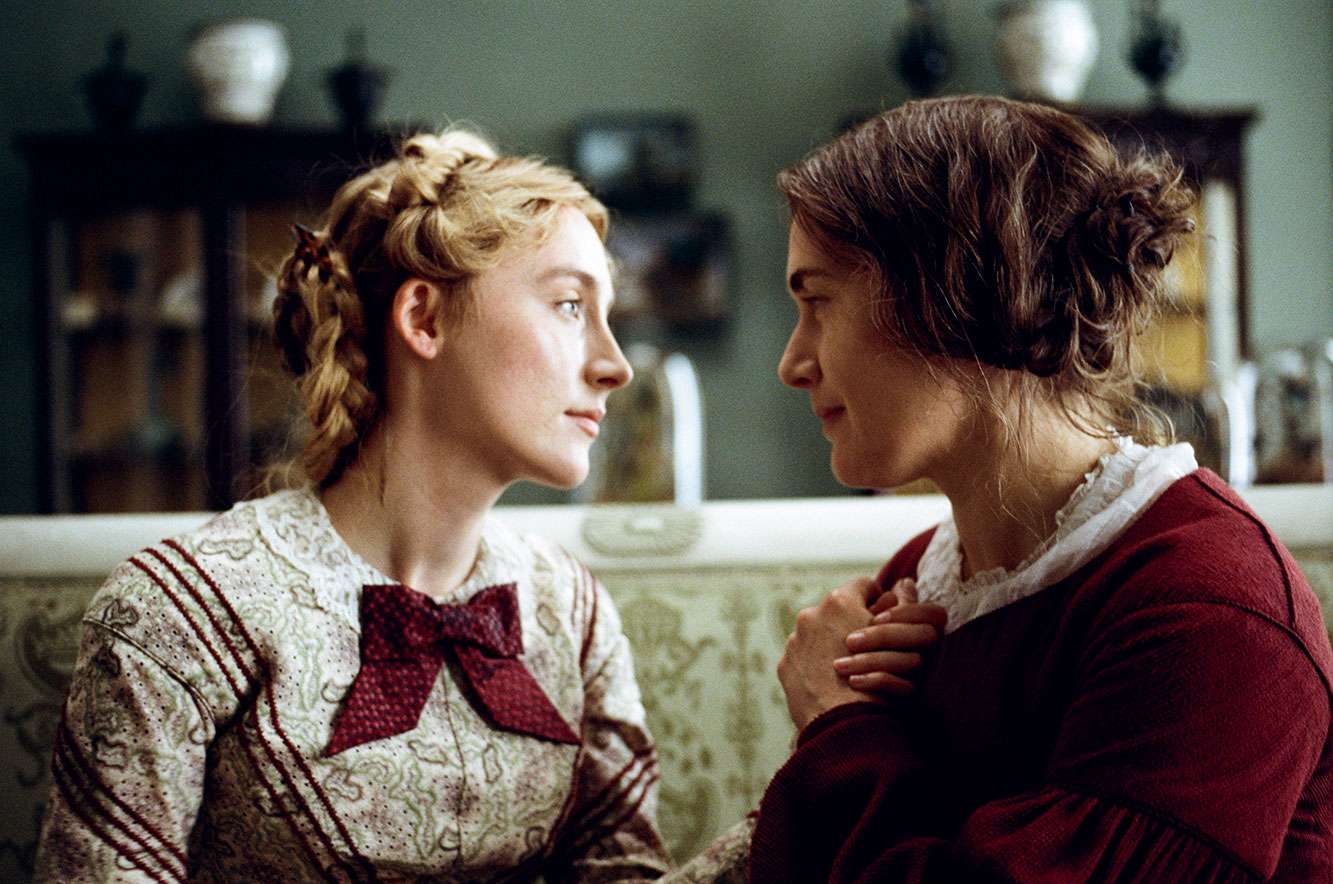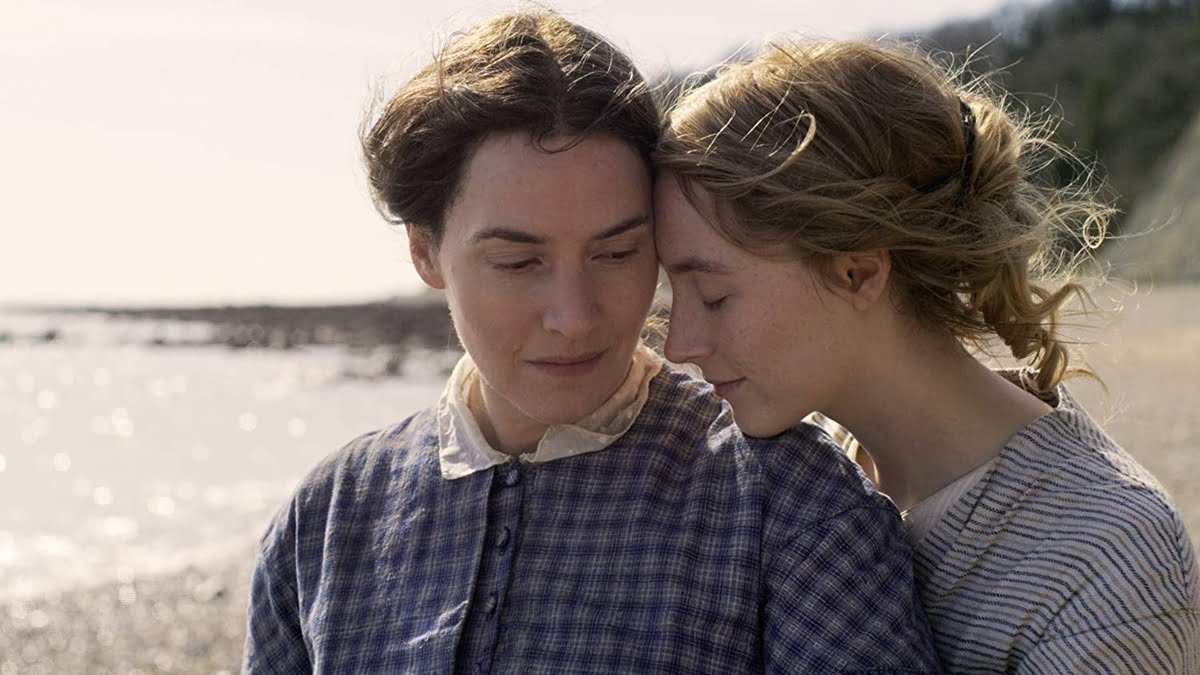Ammonite (2020), directed by Francis Lee, is a fictional love story between two non-fictional characters – the famous British paleontologist Mary Anning (Kate Winslet) and lesser known British geologist Charlotte Murchison (Saoirse Ronan). It is based in Lyme, a small town in 1840s England. Ammonite tells the story of their companionship, which ironically seemed to have been catalysed by Charlotte’s husband, another geologist by the name of Roderick Murchison. Mary is involved in excavating ammonites, a term given to fossils found in the Jurassic period, identifiable by the intricate suture lines cutting across them like a wheel. The film throws into relief the class and gender structures of the time, simultaneously threatening subversion when the patriarchs are not looking.
Ammonite revolves around Mary and the curio shop she has inherited from her father, who passed away when she was young. She uses the nearby beach to find rocks, devising novel methods to extract them from their natural habitats, cleaning and cataloguing them. The curio store also holds other small tidbits, mirrors framed with cowries, for instance, which in Mary’s words were “cheap tourist fodder”, hinting at the fact that her profession didn’t pay well. She lives with her mother, Molly (Gemma Jones) who has a set of tiny white porcelain figurines, which she cleans diligently at the end of every day. We find out later in the story that each of those eight figurines signified each of the eight children that Molly lost during her lifetime.
Also read: The Fetishisation Of Lesbian Relationships In Cinema And Pop Culture
It is on one of the days that Mary is hard at work at the curio store that Roderick Murchison pays her a visit. He is accompanied by his wife, Charlotte – a quiet, distracted woman, who is lightly rebuked by Mary for fiddling with the fossils in the shop. After Roderick strikes up an initial friendship with her, it is impressed upon the audience, in this case also Mary, that Charlotte is suffering from a case of “mild melancholia” and that the doctor had suggested a holiday by the sea. He enlists Mary’s help to assist Charlotte in the recovery, as he himself would soon be leaving on an European expedition. Mary is against the idea of having an apprentice, but once Roderick assures her that he is only looking for a walking partner for Charlotte and would pay handsomely, she reluctantly agrees, under the persistent eye of her mother.

On the first day they go walking, Charlotte and Mary start off on the wrong foot. Mary explains to Charlotte her pecuniary motivations for agreeing to help her. Indignant, Charlotte goes for a swim in the sea and falls sick, and the doctor, obviously flirting with Mary, suggests that she take care of Charlotte while she recovers. This suggestion is pregnant with the idea that women are naturally caregivers, and that Mary would make a good nurse, despite the fact that she engaged in hard physical labour on the daily while excavating fossils. Mary does rise to the occasion, despite Molly reminding her that this should warrant more money from Charlotte’s husband. Soon after, Charlotte recovers, and finds an unlikely friend in Mary. One cannot tell precisely what triggers her affection towards Mary, but one can suppose that she was touched by the way Mary nursed her back to health.
There are several scenes in Ammonite which attest to the class differences in Charlotte and Mary’s developing intimacy. When they go to a musical night at a friend’s house, Charlotte dresses for the occasion, and easily mingles with the elite classes of Lyme. Mary, on the other hand, feels out of place, and is jealous of Charlotte’s easy interactions with her townsfolk.
There are several scenes in Ammonite which attest to the class differences in Charlotte and Mary’s developing intimacy. When they go to a musical night at a friend’s house, Charlotte dresses for the occasion, and easily mingles with the elite classes of Lyme. Mary, on the other hand, feels out of place, and is jealous of Charlotte’s easy interactions with her townsfolk, something her callused hands and modest lifestyle had often precluded her from. Alternatively, it may also seem that the jealousy was driven by the fact that Charlotte was mingling with an ex-lover of Mary’s (played by British actor Fiona Shaw), shown towards the beginning of the film when Mary goes to her to ask for some salve for the convalescing Charlotte. Mary leaves the party angry and when Charlotte finds her, she reassures her that Mary was the “most fascinating and beautiful person in the room”. Another scene that highlights this class divide takes place when Mary tries to sell a fossilised rock to a man reluctant to part with his money. Charlotte waltzes into the room, almost as Mary’s savior, and expounds to him the labours that go into excavating such rocks, thus compelling him to pay a good price, but also making transparent the class difference that endowed Charlotte with her confidence and oratory skills.
As I have mentioned above, Charlotte herself was a geologist, yet Ammonite in no way refers to her profession, apart from recovering from what it seemed was a miscarriage. In fact, as the motivations of their characters get more pronounced as the film progresses, it seems like Charlotte is a timid woman who doesn’t have much say in the way she lives her life: at dinner with Charlotte, her husband orders a lavish spread for himself and “plain whitefish, baked, no sauce” for Charlotte; when she finally recovers from her illness, she asks Mary whether she is fully recovered and Mary tellingly turns to her, asking “Do you think you are well?”
The intimacy that develops between them seems equal parts strained and tender. There is sexual energy between them, but there is also a sense of maternal care, probably because of the age difference between Mary and Charlotte. In one scene in Ammonite, Charlotte tells Mary that she feels like a child when Mary takes care of her. While the scene where they make love is passionate and urgent, not least because Charlotte has been asked to return to London soon by her husband, it is also a scene that denotes care and affection. In nursing Charlotte, Mary discovers a part of herself that was lost in the everyday of caring for her mother. They find intimacy, companionship and solace between each other that seems equal – Mary as a paleontologist whose career wouldn’t really take off, not during her lifetime, because of the patriarchal shackles of conduct that made it easier for men to have such careers, and Charlotte as a geologist, whose sole identity in life in that period was that of a woman who had miscarried. The performances by both Ronan and Winslet in Ammonite are nuanced, and the inner conflict both characters go through in carrying out a clandestine relationship of that nature in 1840s England is well reflected by them in minimal dialogue, powerful expressions and a kind of quiet correspondence.
Francis Lee, the director, places a love story between Mary and Charlotte without any historical veracity to it. He says in one of his interviews that he came across Mary Anning’s name when he was on promotional tour for his film God’s Own Country (2017) and was looking for places to buy fossils as souvenirs for his loved ones. He read further about Mary’s life and found no trace of a heterosexual relationship in her lifetime, but numerous close friendships with women. It was then that he thought of a fiction based on Mary; there is no actual history of any such relationship ever having developed between Mary and Charlotte, but to be fair, records of such relationships between women during that time are hard to come by.
I really enjoy films that delve deeper into the nuances of female companionships, and Ammonite does shed light into the various aspects of such relationships that do not involve sexual intimacy alone. For instance, I admit to giving a little whoop when Charlotte and Mary, with their joint effort managed to dislodge a large rock from its resting place on a small hill. Or the way Mary’s character can almost be seen as a typical millennial nerd minus the glasses. She surely but gently spouts information about the rocks she excavates – about the sutures on one, and fin-like projections on another; it makes watching the film all the more compelling. In fact their subversion hits home hardest when Mary recites a poem ripe with sexual innuendos lying naked in bed, and Charlotte asks her to repeat it amidst obvious pleasure. It is an intimate scene, much more private than their lovemaking, which seemed to explode on the screen amidst loud moans, punctuated by silences or soft dialogue in the rest of the film. The intimacy in their companionship is palpable, but their lovemaking seems to be commercial, tailored for a male gaze.
There is an intimate scene in Ammonite, much more private than their lovemaking, which seemed to explode on the screen amidst loud moans, punctuated by silences or soft dialogue in the rest of the film. The intimacy in their companionship is palpable, but their lovemaking seems to be commercial, tailored for a male gaze.

At the end of Ammonite, Mary goes to visit Charlotte in London and finds that Charlotte has made plans for Mary to move into her house. She seems insulted, not only by the fact that she wasn’t consulted in the making of this decision, but also by the fact that Charlotte’s husband wouldn’t come to know the truth of it, and would possibly assume that she was there solely as Charlotte’s friend. Charlotte suggests that in London, Mary could concentrate on “her real scientific work”, hinting at the manual labour that she deemed beneath her and beneath someone like Mary, but that Mary didn’t mind. Mary gets angry, leaves, and goes to the British Museum to see the Ichthyosaurus for the first time – a rock she had excavated when she was eleven, which now bears no mention of her. There is pride in her eyes, but also sorrow at having been effaced so easily from her work. Therein probably lay the fear in Mary’s heart – of having given up her freedom in exchange for money, a mistake she didn’t want to repeat by taking Charlotte’s offer.
Featured image source: IMDb
About the author(s)
Himalika is slowly beginning to get the hang of being an adult, despite being a bad cook. She will take most things with a sense of humour and is constantly striving to infuse feminist practices in her research.




